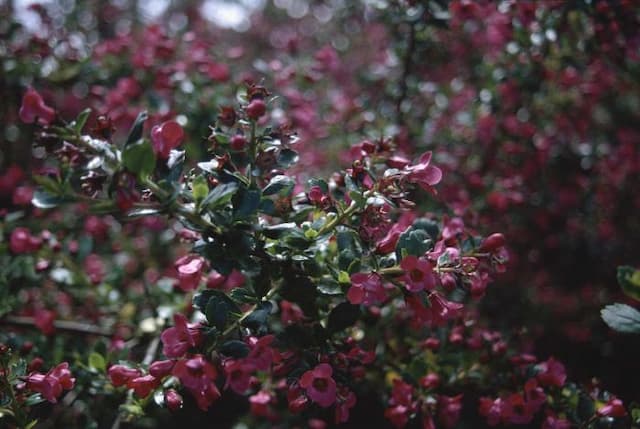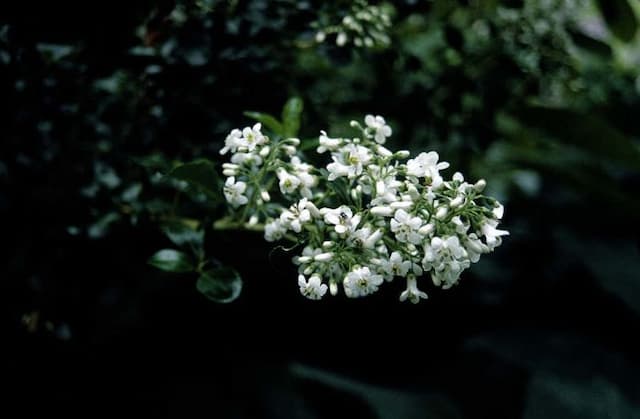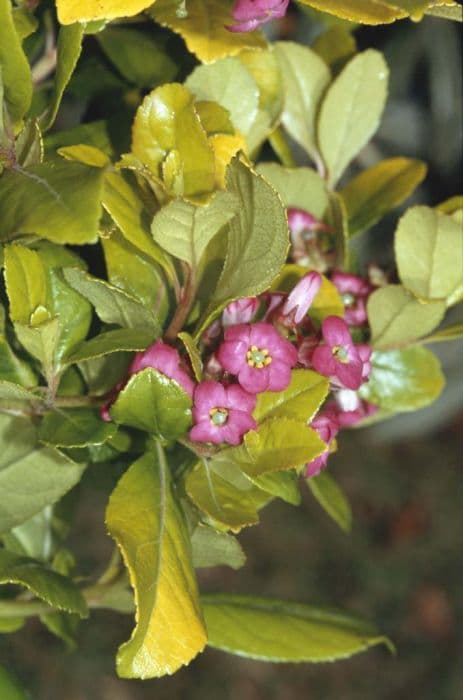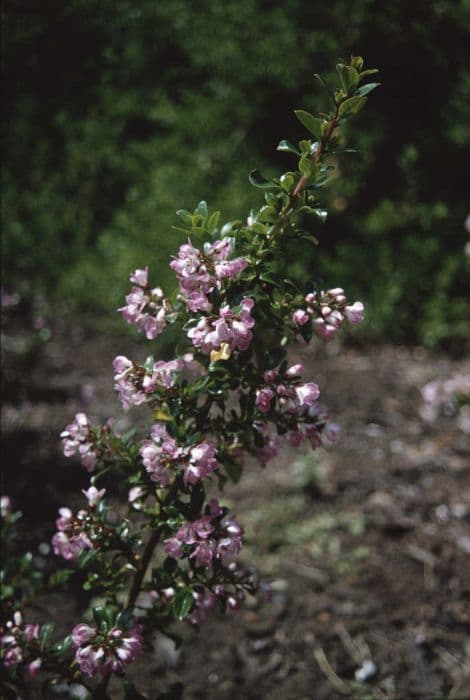Red Elf Escallonia Escallonia 'Red Elf'

ABOUT
Escallonia 'Red Elf' is a compact, evergreen shrub known for its showy and vibrant blooms. The plant is adorned with glossy, dark green leaves that serve as a striking backdrop for its abundant flowers. These flowers manifest in bright clusters of rich red, tubular blossoms which become a hub of activity for bees and hummingbirds. The leaves are small, oval-shaped, and slightly toothed at the edges, adding a textured appearance to the foliage. When in full bloom, typically during the late spring to summer months, the Escallonia 'Red Elf' creates a dazzling display with its crimson flowers densely packed in clusters, creating a vivid contrast with the lush greenery.
About this plant
 Names
NamesFamily
Escalloniaceae
Synonyms
Red Elf Escallonia
Common names
Escallonia 'Red Elf'.
 Toxicity
ToxicityTo humans
Escallonia, including the 'Red Elf' cultivar, is not typically known to be toxic to humans. There is limited information on its toxicity, and it is not generally associated with serious health risks if ingested. Still, it is always wise to avoid eating plants that are not commonly recognized as food, as individual reactions can vary.
To pets
Escallonia, the 'Red Elf' cultivar included, is not widely recognized as being toxic to pets. There is not much information available on its effects if ingested by animals. However, caution should be exercised as pets can have individual sensitivities, and consuming non-food plants can sometimes result in mild gastrointestinal upset. It is best to keep an eye on pets and prevent them from ingesting plants that are not part of their regular diet. If you notice any unusual symptoms after ingestion, consult a veterinarian.
 Characteristics
CharacteristicsLife cycle
Perennials
Foliage type
Evergreen
Color of leaves
Green
Flower color
Red
Height
3 feet (0.91 meters)
Spread
3 feet (0.91 meters)
Plant type
Shrub
Hardiness zones
7
Native area
South America
Benefits
 General Benefits
General Benefits- Attractive Flowering: Escallonia 'Red Elf' blooms with vibrant red flowers that attract butterflies and hummingbirds, adding aesthetic value to gardens.
- Drought Tolerance: Once established, this plant has a good level of drought resistance, making it suitable for xeriscaping or regions with low water availability.
- Low Maintenance: It generally requires minimal care beyond occasional pruning, making it a convenient choice for busy gardeners.
- Evergreen Foliage: Its evergreen leaves ensure year-round color and structure in the garden, making it an excellent backdrop for other plants.
- Wind Resistance: This plant can tolerate and provide shelter from coastal winds, making it a good hedge or screen in exposed areas.
- Fast Growth: Escallonia 'Red Elf' tends to grow quickly, which allows for rapid establishment and coverage in garden spaces or when used for privacy.
- Pest Resistance: It is relatively resistant to common garden pests, decreasing the need for chemical treatments.
- Versatility: The plant can be used for ornamental hedges, borders, foundation plantings, or as a stand-alone specimen, offering versatility in landscaping design.
- Deer Resistance: It is often avoided by deer, reducing the risk of damage in areas where deer browsing can be problematic for gardeners.
 Medical Properties
Medical PropertiesThis plant is not used for medical purposes.
 Air-purifying Qualities
Air-purifying QualitiesThis plant is not specifically known for air purifying qualities.
 Other Uses
Other Uses- Escallonia 'Red Elf' can be used as a natural hedge or privacy screen due to its dense foliage and relatively fast growth rate.
- Its resilient nature makes it suitable for coastal gardens where it can withstand salty winds and sandy soils.
- This plant's compact size allows it to be grown in containers for urban balconies or patios that have limited space.
- The vibrant flowers can be used in cut flower arrangements to add a splash of color indoors.
- Because of its attractive form, the plant is often used in ornamental topiary gardens.
- Its evergreen leaves make it an appealing option for winter gardens as it retains color and structure all year round.
- Escallonia 'Red Elf' can be planted as part of a wildlife garden to attract pollinators such as bees and butterflies.
- Due to its tolerance to pruning, this plant is suitable for creating intricate garden mazes or borders.
- It can serve as a backdrop in mixed shrub borders to highlight other plants with its dark green leaves and red blossoms.
- In urban areas, it can be used for roadside plantings as it is relatively tolerant of pollution.
Interesting Facts
 Feng Shui
Feng ShuiThe Escallonia is not used in Feng Shui practice.
 Zodiac Sign Compitability
Zodiac Sign CompitabilityThe Escallonia is not used in astrology practice.
 Plant Symbolism
Plant Symbolism- Resilience: Escallonia 'Red Elf', with its evergreen foliage and hardiness, often symbolizes resilience as it retains its leaves all year round, enduring various conditions.
- Protection: The dense habit of this shrub might represent protection, providing shelter for wildlife and a protective barrier in gardens.
- Vibrant Energy: The bright red flowers of the 'Red Elf' convey a sense of vibrant energy and enthusiasm, reflecting its robust flowering nature.
- Boundaries: Often used as hedging, the escallonia can symbolize setting boundaries, representing privacy and personal space.
 Water
WaterThe Red Elf Escallonia should be watered deeply to encourage root growth, which typically means applying approximately 1 to 2 gallons of water per plant. During the active growing season in spring and summer, watering should be done weekly, especially in the absence of rainfall. In the fall and winter, you can reduce the frequency to every couple of weeks, depending on the weather conditions. Always check the soil moisture before watering; the top couple of inches of soil should be dry to the touch. Over-watering can lead to root rot, so it is important to ensure good drainage and avoid letting the plant sit in waterlogged soil.
 Light
LightRed Elf Escallonia thrives best in full sun to partial shade. To promote healthy growth and abundant flowering, place the plant in a location where it receives at least six hours of direct sunlight daily. If situated in too much shade, the plant may become leggy and produce fewer flowers.
 Temperature
TemperatureRed Elf Escallonia prefers moderate to warm temperatures and is hardy in USDA zones 6 through 9. It can tolerate temperatures as low as 0 degrees Fahrenheit during dormancy in winter and enjoys temperatures between 65 to 75 degrees Fahrenheit during the growing season. Extreme heat above 90 degrees Fahrenheit may cause stress to the plant if not properly watered.
 Pruning
PruningPruning the Red Elf Escallonia is essential for maintaining its shape and encouraging bushier growth. The best time to prune is in late winter or early spring, just before the new growth starts. It can be pruned annually or biannually, depending on its growth rate and desired size. Remove any dead or diseased wood, and trim back any overgrown branches to maintain the plant's shape.
 Cleaning
CleaningAs needed
 Soil
SoilEscallonia 'Red Elf', commonly known as Red Elf Escallonia, thrives in well-draining, fertile soil with a slightly acidic to neutral pH between 6.0 and 7.5. The best soil mix can be created by combining two parts garden soil, one part peat moss, and one part perlite or coarse sand to ensure proper drainage and aeration. An annual layer of organic mulch can help maintain soil conditions and support health.
 Repotting
RepottingRed Elf Escallonia typically does not require frequent repotting. If this shrub is grown in a container, it should be repotted every 2 to 3 years or when it has become clear that the current pot is too small to support its growth. Spring is the best time for repotting to minimize stress on the plant.
 Humidity & Misting
Humidity & MistingRed Elf Escallonia, as an outdoor shrub, is quite adaptable to various humidity levels and does not require specific humidity conditions indoor. It generally does well in the average humidity found in outdoor environments, making it relatively easy to care for in terms of humidity requirements.
 Suitable locations
Suitable locationsIndoor
Place in bright, indirect light with some direct sun.
Outdoor
Plant in well-draining soil, full sun to partial shade.
Hardiness zone
7-9 USDA
 Life cycle
Life cycleThe life of the Red Elf Escallonia begins with the germination of its seeds in the soil when conditions are moist and warm. Seedlings emerge and establish a root system while beginning to grow their first sets of true leaves. As the plant matures, it enters a vegetative stage, growing steadily and forming a dense, bushy shape with glossy green foliage. Once mature enough, Red Elf Escallonia will enter its flowering stage, typically in early summer, producing clusters of bright red, tubular flowers that attract pollinators such as bees and butterflies. After pollination, the plant sets seed, which may drop to the ground and eventually lead to new plants if conditions allow. In appropriate climates, the Red Elf Escallonia can maintain its evergreen foliage year-round, with the cycle of growth and flowering reoccurring annually.
 Propogation
PropogationPropogation time
Spring-Early Summer
The Escallonia 'Red Elf', commonly known as Red Elf Escallonia, is typically propagated through semi-hardwood cuttings. To propagate Red Elf Escallonia, the best time is late summer to early fall when the plant's growth has begun to slow and the wood has started to harden. Select a healthy, disease-free branch and cut a piece about 4 to 6 inches (10 to 15 centimeters) long, making sure it has several leaves. Remove the leaves from the lower half of the cutting and dip the cut end into a rooting hormone to increase the chances of successful rooting. Plant the cutting in a well-draining potting mix, ensuring the leafless part is buried. The pot should then be placed in a warm, shaded area and maintained moist. Roots typically develop within a few weeks to a couple of months, after which the new Escallonia plants can gradually acclimate to more sunlight before being transplanted outdoors.


![Escallonia [Golden Carpet]](/_next/image?url=https%3A%2F%2Fplants-admin.emdemapps.com%2Fimages%2Fplants%2F%2Fimages%2F604b59284be41.png&w=640&q=75)


![Escallonia [Pink Elle]](/_next/image?url=https%3A%2F%2Fplants-admin.emdemapps.com%2Fimages%2Fplants%2F%2Fimages%2F604b630962bc2.png&w=640&q=75)



